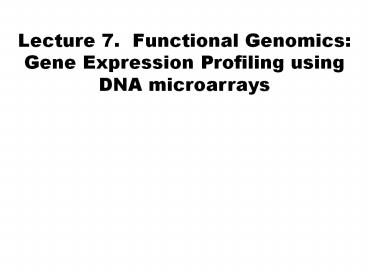Lecture 7. Functional Genomics: Gene Expression Profiling using - PowerPoint PPT Presentation
1 / 25
Title:
Lecture 7. Functional Genomics: Gene Expression Profiling using
Description:
Fibroblast Growth Factor RNA After growth factor stimulation Example: Growth factor stimulation Of Fibroblast Proliferation cDNA (Fluorescent label) ... – PowerPoint PPT presentation
Number of Views:63
Avg rating:3.0/5.0
Title: Lecture 7. Functional Genomics: Gene Expression Profiling using
1
Lecture 7. Functional Genomics Gene Expression
Profiling using DNA microarrays
2
Functional Genomics Development and Application
of Genome-Wide Experimental Approaches to Assess
Gene Function by making use of the information
and reagents provided by Structural Genomics
3
Goals of Functional Genomics 1)DNA 2)RNA 3)
Protein 4) Whole organism 5) Society
Lander, E. 1996. The New Genomics Global Views
of Biology. Science 274 536-539.
4
2. RNA Simultaneous monitoring of the
expression of all genes EG What do gene
expression patterns look like in tumor vs. normal
cells? What about following chemotherapy? Will
reveal Regulatory Networks
5
Gene Expression Profiling Experimental Strategies
for Analyzing Gene Expression Patterns 1)
Sequencing of cDNA Either complete cDNAs or
partial cDNAs (Serial Analysis of Gene Expression
SAGE technique) 2) DNA Microarrays-"Chip"
technologies a) oligonucleotides synthesized in
situ on glass slides using light
directed combinatorial chemistry b) "printing"
of cDNA onto glass slides Two things to
consider -the chip -how to label the RNA for
hybridization to the chip
6
A. Oligonucleotide chip
Multiple Oligonucleotides synthesized in situ on
glass slides using light directed combinatorial
chemistry
7
Oligonucleotide chip 10-20 25mer oligos
represent each mRNA Control same oligos with a
one bp mismatch _at_ center
8
Example Simultaneous monitoring of gene
expression in yeast grown in rich media or after
starvation. Wodicka, Dong, Mittmann, Ho, and
Lockhart. 1997 Genome-wide expression monitoring
in S. cerevisiae. Nature Biotech. 15
1359-1367. 1) 1.28 X 1.28 cm chip contains 65,000
independent 25-mer oligonucleotides. 70,000
copies of each individual oligo per slot on the
chip 2) 6200 yeast gene each represented by 20
different oligonucleotides 6200 X 20 128,000
oligos 3) Control- For each oligo, also
synthesize a second oligo having one base
mismatch (center base in the 25 mer) Total of
260,000 oligos on 4 chips total is about 1 sq.
in.
9
RNA from yeast cells
starved
In rich media
10
B. cDNA microarrays a) PCR amplify individual
cDNA clones (500-1000 bp) displayed in 96 well
dishes b) stamp each well on a glass slide
(robot) 1 ul of DNA per spot. Denature and
bake the DNA onto the glass slide c) label test
and control RNA with different fluorescent
markers d) hybridize to the chip detect
hybridization by color of fluorescence
11
Density of microarray is not as great however
cDNA is longer and hybridization more efficient
than oligonucleotide hybridization (remember
hybridization is COOPERATIVE). EM of cDNA
Microarray
12
Ex. MLI cells (green) vs. irradiated ML1 cells
(red)
13
Alternative to PCR Amplified sequences Long
(70-80) Oligonucleotides Spotted in the Same
Manner
14
(No Transcript)
15
Detection Limit can be INCREASED depending on how
RNA is labeled
16
(No Transcript)
17
DATA ANALYSIS
In a typical experiment, several hundred-or even
several thousand- genes might change expression
pattern when two conditions are compared! How do
you make sense of this massive amount of data?
Cluster Analysis
Tamayko et al. 1999. Interpreting patterns of
gene expression with self-organizing maps
methods and application to hematopoietic
differentiation. PNAS 962907-2912
SELF ORGANIZING MAPS (SOMS)
Mathematical technique for identifying underlying
patterns in complex data arrays. Essentially
clusters data points in multidimensional space.
SOMS impose structure on a data set, clustering
like data in nodes. GENECLUSTER program
developed to produce SOMS from microarray
dataand available from these authors
18
Example An oligonucleotide microarray containing
6416 genes (5223 known, 1193 unknown ESTs) was
used to monitor gene in HL60 cell line induced to
differentiate into macrophage-like cells by
phorbol ester (PMA) treatment Cells were treated
for 0, 0.5, 6 or 24 hrs with PMA, RNA extracted
for each treatment, and used to make cRNA. The
analysis indicated that the expression of 567
genes varied by more than 4-fold.
19
4X3 SOM of the HL60 data
Node
Related nodes are closer together in the SOM
20
More complicated example differentiation of four
cell lines was studied by microarray analysis
two that differentiate into macrophages (HL60
U937) one into neutrophils (NB4), and one into
activated T-cells (Jurkat) 1,036 genes varied in
the analysis 6X4 SOM representing the data
21
HIERARCHICAL CLUSTERING Relationships among
objects (genes) are represented by a tree whose
branch lengths reflect the degree of similarity
between the objects, as assessed by a pairwise
similarity function. In sequence comparison,
these methods are used to infer the evolutionary
history of sequences being compared.
22
For analysis of gene profiling data such methods
are useful in their ability to represent varying
degrees of similarity and more distant
relationships among groups of closely related
genes, as well as in requiring few assumptions
about the nature of the data. The computed trees
can be used to order genes in the original data
table, so that genes or groups of genes with
similar expression patterns are adjacent. The
ordered table can then be displayed graphically,
with a representation of the tree to indicate the
relationships among genes.
23
After growth factor stimulation
Example Growth factor stimulation Of Fibroblast
Proliferation
Eisen MB, Spellman PT, Brown PO, Botstein D.
1998. PNAS 9514863-14868.
Growth Factor
http//rana.lbl.gov/EisenSoftware.htm
Greenincreased expression
Fibroblast
RNA
cDNA (Fluorescent label)
vs. cDNA from unstimulated
cells
Reddecreased expression
24
Hierarcical Cluster Analysis of 3800 Yeast Genes
whose expression changed one or more times
under 365 different experimental
treatments (including genetic manipulation,
drugs, growth conditions)
Known genes all involved in yeast mating
Hypothesis Unknown Genes are involved in yeast
mating
25
(No Transcript)































